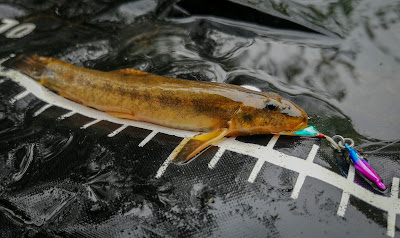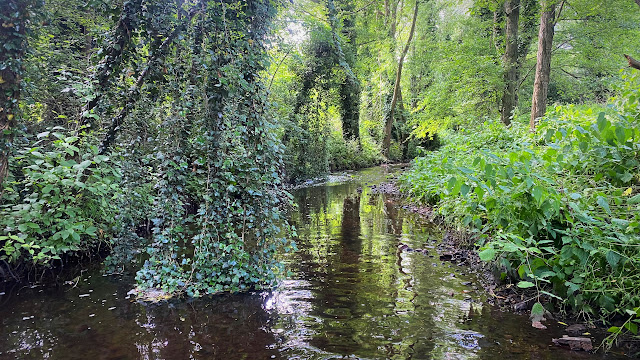I fancied a new challenge in the new river season, something that could fit in with my limited fishing time and something that I could get my teeth in to.
Something that wouldn't take long to get fishing on a local river venue that could provide that new quest to keep me interested in this fishing lark. I get bored doing the same thing, my ever growing collection of rods are testament to that.
Now there is nothing new about targeting stone loach by design it appears, you see looking for my next challenge having found a dead stone loach washed up in my local river, I stumbled upon the puny piscatorial pursuits of Peter Baker (see his lure caught fish below) and others who have caught them on metal lures, small flies and tiny imitation worms on small streams an brooks.
Now there are two species of loach, the stone loach (Nemecheilus barbatula), which is by far the commoner, and the spined loach (Cobitis taenia), which is not found in Scotland, Ireland, or Wales, and in England seems to be limited to the Midlands and Wiltshire.
The spined loach takes its name from the 2 spines situated one on each side of its head. Both species of loach are of a brown, mottled colour and average about 3 ins. in length.
Around the mouth they have a cluster of six barbels, or feelers, which vary in size between the species, the stone loach having two long and four short, and the spined loach six of equal length.
Loach may be confused by the inexperienced with gudgeon or with very young barbel, but the number of barbels will readily identify them.
The loach has six, the barbel four, and the gudgeon only two. An unusual feature of the loach is its scales, which lie flat and do not overlap. Both species make excellent spinning and dead-bait for perch, pike, trout and salmon. Loach fished on leger tackle have also accounted for barbel.
The stone loach may be found in fast-flowing streams and brooks in most parts of the British Isles; it is also found quite frequently in canals and in still water. Its favourite hiding place is among the stones on the bottom. Being
The end is pin thin so ideal really I don't know why I didn't have a thought about giving it a go sooner. Now baits well, I told Martyn in the tackle shop to bung a few pinkies in with the maggots because being half the size of the maggots they are also perfect for the intended quarry.
almost entirely carnivorous, it is always ready to make a meal of any aquatic creature small enough for it to tackle that the current brings near. Spined loach have similar habits. Loach are rarely fished for deliberately except as bait. The best way of catching them is therefore the simplest and quickest, namely, with a net for some 'pond dipping'
A triangular landing-net frame which has been fitted with a fine meshed net (minnow mesh) and attached to a 4 ft handle is ideal. It is best to wade in the stream with the net moving ahead along the bottom. Swift movements of the net around the larger stones should catch plenty of fish.
In years gone by apparently if you have loach bait left over at the end of the day's fishing, you can take them home, sort them into size groups, and preserve them in formalin solution for use later as spinning baits. Incidentally, loach caught in sufficient numbers and cooked soon after catching are reckoned to be a delicacy.
Diminutive fish means a different approach than my cumbersome norm so I cobbled together some pieces of tackle and a couple of purchases too to put the plan in to action.
A good thing is the river where one dead was discovered is 5 mins away by car so short evening sessions in to dusk can be fitted in quite easily in my ever busy schedule. The rod well I decided to repurpose the tenkara rod because if any rod will be bent by a stone loach and also be able to withstand a kamikaze trout it's the tenkara rod.
The end is pin thin so ideal really I don't know why I didn't have a thought about giving it a go sooner. Now baits well, I told Martyn in the tackle shop to bung a few pinkies in with the maggots because being half the size of the maggots they are also perfect for the intended quarry.
I bet some surprises will turn up especially bullheads I'd imagine but hey, got to try and tick another species off caught on rod and line.
Watch this space !! I bet you cannot wait 😄
I roped in Sam to explore a small Henley River not far from us to see if that was worth a dabble too. The river was very low indeed despite the recent rain and didn't spot a single fish despite roving up and down quite a bit of it.
There were deeper areas that I'm sure would have held fish but without a rod or a net it was a fruitless task. So the Alne for now and then we might cast the net wider so to speak.












I want one.
ReplyDeleteGood luck boi !
Cheers Gale :)
DeleteGood luck, I’ll be interested to read about this campaign. I saw hundreds of them while wading about in The Wye last summer - might have to give them a whirl myself
ReplyDeleteWell the rod up is set-up ready to go now looking forward to it Brian...!!
Delete